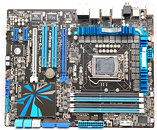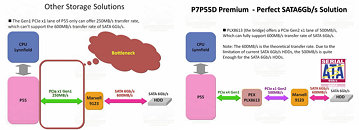- Joined
- Oct 9, 2007
- Messages
- 47,233 (7.55/day)
- Location
- Hyderabad, India
| System Name | RBMK-1000 |
|---|---|
| Processor | AMD Ryzen 7 5700G |
| Motherboard | ASUS ROG Strix B450-E Gaming |
| Cooling | DeepCool Gammax L240 V2 |
| Memory | 2x 8GB G.Skill Sniper X |
| Video Card(s) | Palit GeForce RTX 2080 SUPER GameRock |
| Storage | Western Digital Black NVMe 512GB |
| Display(s) | BenQ 1440p 60 Hz 27-inch |
| Case | Corsair Carbide 100R |
| Audio Device(s) | ASUS SupremeFX S1220A |
| Power Supply | Cooler Master MWE Gold 650W |
| Mouse | ASUS ROG Strix Impact |
| Keyboard | Gamdias Hermes E2 |
| Software | Windows 11 Pro |
Here's our ASUS P55 motherboard of the day: the P7P55D Premium. Positioned in the high-end segment of socket LGA-1156 motherboards, this board boasts of support for SATA III 6 Gbps. Associated with the SATA III controller, is also an interesting feature. To begin with, the CPU is powered by a digital PWM circuit with "32+3" phases. Sure there are that many chokes, but we do suspect choke redundancy here. The CPU is wired to four DDR3 DIMM slots to support dual-channel memory.
Unlike the P7P55D Deluxe, this board makes do with two PCI-E 2.0 x16 slots, each of which arrange to 8-lanes PCI-E when both are populated. Other expansion slots include two PCI-E x1 and two PCI. Connectivity options include two gigabit Ethernet controllers, 8 channel audio, and a number of USB and Firewire ports. From the looks of it, there's also a place-holder for the NEC µPD720200 USB 3.0 controller, and its marked blue-coloured USB ports, though it's MIA.

The P55 PCH provides six SATA II ports, and an additional Marvell 88SE9123 controller gives out two next-generation SATA III ports. ASUS used an interesting (and expensive) method of making sure the controller works to its full potential. A PCI-Express 2.0 switch was added to the board, that connects to all the four PCI-E 1.1 lanes the P55 PCH provides, and gives out 12 PCI-E 2.0 lanes, with support for three ports in all. One of these ports, configured as PCI-E 2.0 x1, connects to the Marvell 88SE9123 (which is a PCI-E 2.0 x1 device) to make sure it is provided with a 500 MB/s interconnect, reducing its bottleneck compared to most other motherboards that simply connect one of the four PCI-E 1.1 lanes from the PCH to it. We think the two PCI-E x1 slots make for the rest of the PLX PCI-E switch's two ports. It is believed that the P7P55D Premium will launch in the next couple of months, if not being part of the first LGA-1156 boards from ASUS.

View at TechPowerUp Main Site
Unlike the P7P55D Deluxe, this board makes do with two PCI-E 2.0 x16 slots, each of which arrange to 8-lanes PCI-E when both are populated. Other expansion slots include two PCI-E x1 and two PCI. Connectivity options include two gigabit Ethernet controllers, 8 channel audio, and a number of USB and Firewire ports. From the looks of it, there's also a place-holder for the NEC µPD720200 USB 3.0 controller, and its marked blue-coloured USB ports, though it's MIA.

The P55 PCH provides six SATA II ports, and an additional Marvell 88SE9123 controller gives out two next-generation SATA III ports. ASUS used an interesting (and expensive) method of making sure the controller works to its full potential. A PCI-Express 2.0 switch was added to the board, that connects to all the four PCI-E 1.1 lanes the P55 PCH provides, and gives out 12 PCI-E 2.0 lanes, with support for three ports in all. One of these ports, configured as PCI-E 2.0 x1, connects to the Marvell 88SE9123 (which is a PCI-E 2.0 x1 device) to make sure it is provided with a 500 MB/s interconnect, reducing its bottleneck compared to most other motherboards that simply connect one of the four PCI-E 1.1 lanes from the PCH to it. We think the two PCI-E x1 slots make for the rest of the PLX PCI-E switch's two ports. It is believed that the P7P55D Premium will launch in the next couple of months, if not being part of the first LGA-1156 boards from ASUS.

View at TechPowerUp Main Site





